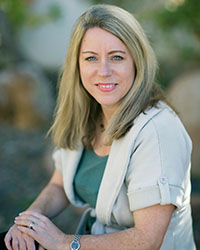The Skies, the Limits
Professor Rebecca Scharf studies how drones potentially intrude on civil liberties

By Paul Szydelko
The COVID-19 pandemic has inspired even more creative uses for drones, but UNLV William S. Boyd School of Law Professor Rebecca Scharf is studying how these overhead devices potentially invade privacy—and how to avoid flying into an Orwellian COVID-1984 surveillance nightmare.
Drones, or unmanned aerial vehicles (UAVs), have been increasingly employed in many limited and invaluable ways, including oil, gas and mineral exploration; real estate, agriculture, and livestock surveying; infrastructure inspection; disaster relief; package delivery; improved cellular service; and filmmaking.
During the coronavirus pandemic, the NFL’s Atlanta Falcons flew drones to spray medical-grade disinfectant in their stadium’s seating areas after a game. Law enforcement agencies have controlled drones with loudspeakers over parks and beaches to remind people of area closures or to socially distance. Drones have also delivered personal protective equipment, medical supplies, and medicines.
Those types of drone uses are perfectly reasonable, Scharf says. But when sensor- or camera-wielding drones stray from these innocuous tasks and violate a reasonable expectation of privacy, citizens should be concerned. Especially since robust regulations and laws about drones have yet to be written.
“To the extent that [drone operators] are not being thoughtful or careful about what they are recording and what they’re doing with the data—if [for example] they’re using facial-recognition technology, then selling it to the police to use it to solve different crimes—those are the types of things that need to be thought through,” Scharf says.
To that point, the city of Westport, Connecticut, proposed using thermal-recognition technology on drones to take and record people’s temperatures without their permission. Civil rights and privacy advocates such as Scharf argue such an act—obtaining the private health information of people who did not give consent and aren’t under a criminal investigation—would constitute an indiscriminate, warrantless search.
A well-established tort called intrusion into seclusion makes arresting and prosecuting a Peeping Tom armed with a camera perched above your backyard wall relatively simple. But that same Peeping Tom flying a drone to capture images or video is much more complicated to prosecute. As a result, a sense of helplessness pervades: How do you capture a drone? How do you find out who the drone owner is? How do you prove the owner’s nefarious intent?
“There is something that seems different about having little flying machines going around recording all this information—when you think about it, they really are flying computers,” Scharf says. “People certainly don’t like the idea of [drones] being able to hover in their backyard and watch them. That makes them really angry.”
Scharf, who joined the Boyd School of Law’s faculty in 2004, suggests that more care and transparency about how data is collected and used can help ensure privacy—and avoid one element of Orwell’s dystopian nightmare. Toward that goal, she’s written articles such as “Game of Drones: Rolling the Dice with Unmanned Aerial Vehicles and Privacy” (2018) and “Drone Invasion: Unmanned Aerial Vehicles and the Right to Privacy” (2019). Next year, she hopes to publish her findings online about drone use and privacy amid the pandemic.